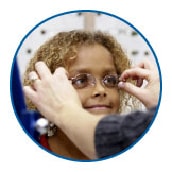Eye Conditions treated in our Las Vegas Eye Practice
Refractive Errors

Refractive errors are the most frequent eye problems in the United States. Refractive errors include myopia (near-sightedness), hyperopia (farsightedness), astigmatism (distorted vision at all distances), and presbyopia that occurs between age 40–50 years (loss of the ability to focus up close, inability to read letters of the phone book, need to hold newspaper farther away to see clearly) can be corrected by eyeglasses, contact lenses, or in some cases surgery. The National Eye Institute states that proper refractive correction could improve vision among 150 million Americans.
Learn more about refractive errors
Age-Related Macular Degeneration

Macular degeneration, often called age-related macular degeneration (AMD), is an eye disorder associated with aging and results in damaging sharp and central vision. Central vision is needed for seeing objects clearly and for common daily tasks such as reading and driving. AMD affects the macula, the central part the retina that allows the eye to see fine details. There are two forms of AMD—wet and dry.
Wet AMD is when abnormal blood vessel behind the retina start to grow under the macula, ultimately leading to blood and fluid leakage. Bleeding, leaking, and scarring from these blood vessels cause damage and lead to rapid central vision loss. An early symptom of wet AMD is that straight lines appear wavy.
Dry AMD is when the macula thins overtime as part of aging process, gradually blurring central vision. The dry form is more common and accounts for 70–90% of cases of AMD and it progresses more slowly than the wet form. Over time, as less of the macula functions, central vision is gradually lost in the affected eye. Dry AMD generally affects both eyes. One of the most common early signs of dry AMD is drusen.
Drusen are tiny yellow or white deposits under the retina. They often are found in people aged 60 years and older. The presence of small drusen is normal and does not cause vision loss. However, the presence of large and more numerous drusen raises the risk of developing advanced dry AMD or wet AMD.
It is estimated that 1.8 million Americans aged 40 years and older are affected by AMD and an additional 7.3 million with large drusen are at substantial risk of developing AMD. The number of people with AMD is estimated to reach 2.95 million in 2020. AMD is the leading cause of permanent impairment of reading and fine or close-up vision among people aged 65 years and older.
Learn more about age-related macular degeneration
Cataract

Cataract is a clouding of the eye’s lens and is the leading cause of blindness worldwide, and the leading cause of vision loss in the United States. Cataracts can occur at any age because of a variety of causes, and can be present at birth. Although treatment for the removal of cataract is widely available, access barriers such as insurance coverage, treatment costs, patient choice, or lack of awareness prevent many people from receiving the proper treatment.
An estimated 20.5 million (17.2%) Americans aged 40 years and older have cataract in one or both eyes, and 6.1 million (5.1%) have had their lens removed operatively. The total number of people who have cataracts is estimated to increase to 30.1 million by 2020.
Diabetic Retinopathy

Diabetic retinopathy (DR) is a common complication of diabetes. It is the leading cause of blindness in American adults. It is characterized by progressive damage to the blood vessels of the retina, the light-sensitive tissue at the back of the eye that is necessary for good vision. DR progresses through four stages, mild nonproliferative retinopathy (microaneurysms), moderate nonproliferative retinopathy (blockage in some retinal vessels), severe nonproliferative retinopathy (more vessels are blocked leading to deprived retina from blood supply leading to growing new blood vessels), and proliferative retinopathy (most advanced stage). Diabetic retinopathy usually affects both eyes.
The risks of DR are reduced through disease management that includes good control of blood sugar, blood pressure, and lipid abnormalities. Early diagnosis of DR and timely treatment reduce the risk of vision loss; however, as many as 50% of patients are not getting their eyes examined or are diagnosed too late for treatment to be effective.
It is the leading cause of blindness among U.S. working-aged adults aged 20–74 years. An estimated 4.1 million and 899,000 Americans are affected by retinopathy and vision-threatening retinopathy, respectively.
Learn more about diabetic retinopathy
Glaucoma

Glaucoma is a group of diseases that can damage the eye’s optic nerve and result in vision loss and blindness. Glaucoma occurs when the normal fluid pressure inside the eyes slowly rises. However, recent findings now show that glaucoma can occur with normal eye pressure. With early treatment, you can often protect your eyes against serious vision loss.
There are two major categories “open angle” and “closed angle” glaucoma. Open angle, is a chronic condition that progress slowly over long period of time without the person noticing vision loss until the disease is very advanced, that is why it is called “sneak thief of sight.” Angle closure can appear suddenly and is painful. Visual loss can progress quickly; however, the pain and discomfort lead patients to seek medical attention before permanent damage occurs.
Amblyopia
Amblyopia, also referred to as “lazy eye,” is the most common cause of vision impairment in children. Amblyopia is the medical term used when the vision in one of the eyes is reduced because the eye and the brain are not working together properly. The eye itself looks normal, but it is not being used normally because the brain is favoring the other eye. Conditions leading to amblyopia include strabismus, an imbalance in the positioning of the two eyes; more nearsighted, farsighted, or astigmatic in one eye than the other eye, and rarely other eye conditions such as cataract.
Unless it is successfully treated in early childhood amblyopia usually persists into adulthood, and is the most common cause of permanent one-eye vision impairment among children and young and middle-aged adults. An estimated 2%–3% of the population suffer from amblyopia.
Strabismus
Strabismus involves an imbalance in the positioning of the two eyes. Strabismus can cause the eyes to cross in (esotropia) or turn out (exotropia). Strabismus is caused by a lack of coordination between the eyes. As a result, the eyes look in different directions and do not focus simultaneously on a single point. In most cases of strabismus in children, the cause is unknown. In more than half of these cases, the problem is present at or shortly after birth (congenital strabismus). When the two eyes fail to focus on the same image, there is reduced or absent depth perception and the brain may learn to ignore the input from one eye, causing permanent vision loss in that eye (one type of amblyopia).
Other Eye and Eye Related Conditions
About Ophthalmology
Adie’s Pupil
Adult Strabismus
Age-Related Macular Degeneration
Albinism
Alzheimer’s Disease, Dementia and the Eye
Amblyopia
Anisocoria
Antibiotic Eye Drops
Anti-VEGF Treatments
Aqueous Humor
Arcus Senilis
Artificial Tears
Astigmatism
Avastin
Bacterial Keratitis
Bell’s Palsy
Black Eye
Blepharitis
Blocked Tear Duct
Blood in Eye
Blood Pressure
Bloodshot Eye
Blue Light
Blurriness
Botulinum Toxin (Botox) for Facial Wrinkles
Bowman’s membrane
Branch Retinal Vein Occlusion (BRVO)
Burning Eyes
Cancer of the Eye
Carotid Arteries
Carotid Artery Disease
Cataract and Glaucoma Surgeries Combined
Cataracts
Cellulitis
Central Retinal Vein Occlusion
Central Serous Chorioretinopathy
Cerebrospinal Fluid (CSF)
Chalazia and Stye
Charles Bonnet Syndrome
Choroid
Choroidal Neovascular Membranes
Chronic Angle-Closure Glaucoma
Ciliary Body
Coloboma
Color Blindness
Color Vision
Colored Rings in the Iris
Colors look dull, faded or different
Computer Use
Cones
Conjunctiva
Conjunctivitis (Pink Eye)
Contact Lens Care
Contact Lenses
Contact Lens-Related Eye Infections
Cornea
Corneal Abrasion
Corneal Cross-Linking
Corneal Dystrophies
Corneal Erosion
Corneal Inlays
Corneal Laceration
Corneal Topography
Corneal Transplantation
Corneal Ulcer
Cosmetic Contact Lenses
Crossed Eyes (Strabismus)
Crow’s Feet
Crusty Eyelid or Eyelashes
Cytomegalovirus Retinitis
Dark Curtain in Vision
Dark Spots in Vision
Dementia and the Eye
Depth Perception
Descemet’s Membrane
Detached Retina
Diabetic Eye Disease
Diabetic Retinopathy
Digital Devices and Your Eyes
Dilated Pupil
Dilating Eyedrops
Discharge From Eye
Distorted Vision
Double Vision
Drainage Angle
Drooping Eyelid
Drusen
Dry Eye
Dry Eye Tips
Dryness
Ectropion
Endophthalmitis
Endothelium
Enlarged Pupil
Entropion
Enucleation
Epithelium
Erectile Dysfunction Medication
Evisceration
Excessive Blinking in Children
Eye Allergies
Eye Anatomy Overview
Eye Cancer
Eye Color
Eye Donation
Eye Drops
Eye Exams
Eye Injections
Eye Injuries
Eye Lymphoma
Eye Muscles
Eye Pressure
Eye Removal Surgery
Eyelashes
Eyelashes and Cosmetics
Eyelid
Eyelid Droop
Eyelid redness and rash
Eyelid rough, red and swollen on inside
Eyelid Spasm and Twitching
Eyelid Surgery
Eyelid Turns Out
Eyes with different colored irises
Eyestrain (Condition)
Eyestrain (Symptom)
Eylea
Face-Down Recovery After Retinal Surgery
Farsightedness (hyperopia)
Feeling of Something in Eye
Flashes of Light
Floaters and Flashes
Floaters in Vision
Fluorescein Angiography
Food and Nutrition
Fovea
Fuchs’ Dystrophy
Fundus
Fungal Keratitis
Giant Cell Arteritis
Giant Papillary Conjunctivitis
Glasses
Glaucoma
Glaucoma and Cataract Surgeries Combined
Gonioscopy
Graves’ Disease
Grittiness
Halos Around Lights
Headache and Eye Problems
Headache Behind Eye
Headache: Eye Conditions That Can Cause Headache
Hemangioma
Herpes Keratitis
Herpes Zoster (Shingles)
Heterochromia
Histoplasmosis
HIV/AIDS and the Eye
Hyperopia (farsightedness)
Hyphema
Idiopathic Intracranial Hypertension
Inflammation, General
Interferon
Intraocular Implants (IOLs)
Intraocular Pressure
Iridocorneal Endothelial Syndrome
Iris
Irritation
Ischemic Optic Neuropathy
Itchiness
Juvenile Idiopathic Arthritis Uveitis
Juvenile Macular Dystrophy
Keratoconus
Lacrimal Gland
LASIK
Latisse (Bimatoprost Ophthalmic Solution)
Lattice Degeneration
Lazy Eye (Amblyopia)
Lens
Lens Capsule
Light Sensitivity
Limited Movement of Eyelid
Limited Movement of Eyes
Low Vision
Lubricating Eye Drops
Lucentis
Lump on Eyelid
Macula
Macular Edema
Macular Hole
Macular Pucker
Macular Telangiectasia
Marfan Syndrome
Marijuana
Meibomian Glands
Microbiome of the Eye
Microvascular Cranial Nerve Palsy
Migraine
Mohs Surgery
Monovision (Blended Vision)
Myasthenia Gravis
Myopia
Narrow Angles
Nearsightedness (Myopia)
Neuropathic Corneal Pain
Nevus
Night Vision
Night Vision Problem
Nystagmus
Objects Appear Smaller or Different Sizes
Ocular Hypertension
Ocular Melanoma
Ocular Rosacea
Onchocerciasis (African River Blindness)
Optic Disc
Optic Nerve
Optic Neuritis
Optical Coherence Tomography
Orbital Fracture
Pain Around Eye
Pain Behind Eye
Pain in Eye
Parts of the Eye
Peripheral Retina
Photokeratitis
Photoreceptors
Pigment Dispersion Syndrome
Pinguecula and Pterygium
Pink Eye (Conjunctivitis)
Pink Eye (symptom)
Plaquenil
Posterior Capsulotomy
Posterior Vitreous Detachment
Pregnancy
Presbyopia
Pseudoexfoliation Syndrome
Pseudostrabismus
Ptosis
Pupil
Red Eye
Red or purple raised legion on or near the eye or eyelid
Redness-Relieving Eye Drops
Reduced Vision
Refractive Surgery
Retina
Retinal Artery Occlusion
Retinal Detachment
Retinitis Pigmentosa
Retinoblastoma
Retinopathy of Prematurity
Ring Around the Cornea
River Blindness (Onchocerciasis)
Rods
Scarring in or on the eyeball
Sclera
Scleritis
Scratched Eye
Screen Use and Safety
Secondary Cataract
Shadow or Dark Curtain in Vision
Shingles (Herpes Zoster)
Sjögren’s Syndrome
Sleep Crust
Slit Lamp
Small Incision Lenticule Extraction (SMILE)
Small pupils
Solar Eclipses
Spasm/Twitching
Sports Eye Safety
Spot on Eye, Brown
Spot on Eye, Cloudy or White
Spot on Eye, Red or Pink
Spot on Eye, Yellow
Spot on Eyelid, Colored
Squinting
Starbursts Around Lights
Stargardt Disease
Steroid Tablets
Stickler Syndrome
Strabismus (Crossed Eyes)
Straight Lines Look Bent or Wavy
Stroma
Stye and Chalazia
Subconjunctival Hemorrhage
Sun and UV Light
Sunglasses
Swelling Around Eye
Swollen Eye
Tear Duct
Tear Film
Tearing
Tears and Crying
Torn Retina
Toxoplasmosis
Trachoma
Transplantation and the Eye
Travel and Eye Health
Trichiasis
Trichotillomania
Tunnel Vision
Two Different Colored Eyes/Irises
Usher Syndrome
Uvea
Uveitis
Veterans
Vision Loss, Central
Vision Loss, General
Vision Loss, Peripheral (Side)
Vision loss, temporary
Vitamin A Deficiency
Vitrectomy Surgery
Vitreomacular Traction
Vitreous
Zonules
